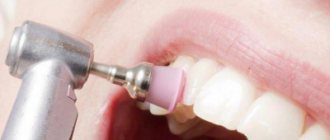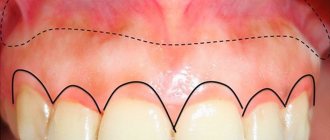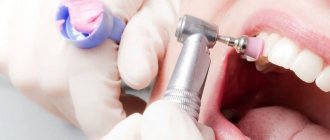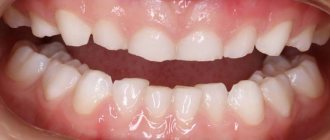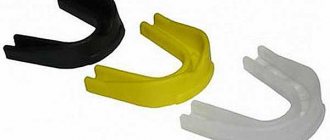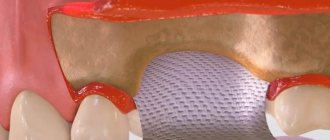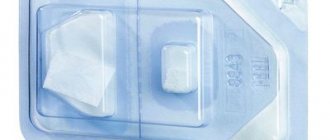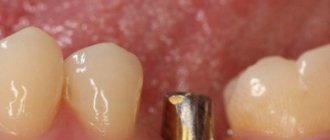Adhesion - this is the connection between dissimilar surfaces brought into contact. The reasons for the occurrence of an adhesive bond are the action of intermolecular forces or chemical interaction forces. Adhesion determines gluing solids - substrates - using an adhesive - adhesive, as well as the connection of the protective or decorative paint coating with the base. Adhesion also plays an important role in the dry friction process. In the case of the same nature of the contacting surfaces, one should speak of autohesion (authesion), which underlies many processes for processing polymer materials. With prolonged contact of identical surfaces and the establishment in the contact zone of a structure characteristic of any point in the volume of the body, the strength of the autohesive joint approaches cohesive strength of the material (see cohesion).
On the interfacial surface of two liquids or a liquid and a solid, adhesion can reach an extremely high value, since the contact between the surfaces in this case is complete. The adhesion of two solids due to uneven surfaces and contact only at individual points is usually small. However, high adhesion can also be achieved in this case if the surface layers of the contacting bodies are in a plastic or highly elastic state and are pressed against each other with sufficient force.
Adhesion, what it is - theoretical foundations
Adhesion is one of the key properties of materials in the following areas:
- Metallurgy – anti-corrosion coatings.
- Mechanics – a layer of lubricant on the surface of machine elements and mechanisms.
- Medicine - dentistry.
- Construction. In this industry, adhesion is one of the main indicators of the quality of work and the reliability of structures.
At almost all stages of construction, adhesion indicators for the following connections are monitored:
- paints and varnishes;
- plaster mixtures, screeds and fillers;
- adhesives, masonry mortars, sealants, etc.
An example of chemical adhesion - the reaction between silicone sealant and glass
There are three basic principles of adhesive bonding of materials. In construction and technology they manifest themselves as follows:
- Mechanical - adhesion occurs by adhesion of the applied material to the base. The mechanism of such a connection is the penetration of the applied substance into the pores of the outer layer or connection with a rough surface. An example is painting the surface of concrete or metal.
- Chemical - the connection between materials, including those of different densities, occurs at the atomic level. To form such a bond, the presence of a catalyst is necessary. An example of this type of adhesion is soldering or welding.
- Physical - electromagnetic intermolecular bonding occurs on mating surfaces. Can be formed as a result of a static charge or under the influence of a constant magnetic or electromagnetic field. An example of its use in technology is painting various surfaces in an electromagnetic field.
Adhesive properties of building and finishing materials
Adhesion of building and finishing materials is carried out mainly according to the principle of mechanical and chemical connection. A large number of different substances are used in construction, the performance characteristics and specific interaction of which are radically different. Let us divide them into three main groups and describe them in more detail.
paints and varnishes
Adhesion of paintwork materials to the surface of the base is carried out according to the mechanical principle. At the same time, maximum strength indicators are achieved if the working surface of the material is rough or porous. In the first case, the contact area increases significantly, in the second, the paint penetrates into the surface layer of the base. In addition, the adhesive properties of paintwork materials are increased thanks to various modifying additives:
- organosilanes and polyorganosiloxanes have an additional water-repellent and anti-corrosion effect;
- polyamide and polyester resins;
- organometallic catalysts for chemical processes of paint and varnish hardening;
- ballast fine fillers (for example, talc).
Talc-filled paint - non-intumescent fire retardant
Construction plasters and dry adhesive mixtures
Until recently, construction and finishing work was carried out using various mortars based on gypsum, cement and lime. Often, they were mixed in a certain proportion, which gave a limited change in their basic properties. Modern ready-made dry construction mixtures: starting, finishing and multi-finish plasters and putties have a much more complex composition. Additives of various origins are widely used:
- mineral - magnesia catalysts, liquid glass, aluminous, acid-resistant or non-shrink cement, microsilica, etc.
- polymeric - dispersible polymers (PVA, polyacrylates, vinyl acetates, etc.).
Such modifiers significantly change the following basic characteristics of building mixtures:
- plastic;
- water-retaining properties;
- thixotropy.
An example of poor adhesion of plaster to a brick wall
Important! The use of polymer modifiers gives a more pronounced effect of enhancing adhesion. However, the formation of stable compounds of polymer films at the interface of different types of materials (base - hardening plaster) is possible only at a certain temperature. This term is called the minimum film formation temperature - MTP. For different plasters it can vary from +5°C to +10°C. To avoid delamination, it is necessary to strictly adhere to the manufacturer's recommendations regarding temperature, both the environment and the substrate.
Sealants
Sealants used in construction are divided into three different types, each of which requires certain conditions for high-strength adhesion to the base material. Let's look at each type in more detail.
- Drying sealants. The composition includes various polymers and organic solvents: styrene butadiene or nitrile, chloroprene rubber, etc. As a rule, they have a paste-like consistency with a viscosity of 300-550 Pa. Depending on the viscosity, they are applied either with a spatula or a brush. After they are applied to the surface, a certain time is required for drying (evaporation of the solvent) and the formation of a polymer film.
Drying acrylic sealant
- Non-drying sealants. They usually consist of rubber, bitumen and various plasticizers. They have limited resistance to high temperatures, no more than 700C-800C, after which they begin to deform.
Non-drying bituminous composition, used for sealing storm drainage systems
- Curing sealants. After their application, under the influence of various factors: moisture, heat, chemical reagents, an irreversible polymerization reaction occurs.
Preparation of two-component polyurethane sealant Sazilast
Of all the listed varieties, curing sealants provide maximum reliability of adhesion to micro-irregularities of the base surface. In addition, they are resistant to high temperatures, mechanical and chemical influences. They have an optimal combination of rigidity and viscosity, allowing them to maintain their original shape. However, they are the most expensive and difficult to use.
Primers of different generations
Over the entire existence of adhesive systems in dentistry, used specifically for dentin, there have been 7 generations of them. There is a tendency to simplify the procedure, but at the same time adhesion becomes higher and of better quality.
The first generation is the very first systems that began to be used around the end of the 70s of the twentieth century. They are good for use when working with enamel, but they attach to dentin rather poorly. Adhesion occurred during the contact of the bond itself and the calcium in the dentin. As a rule, the first problems of such systems began to appear several months after the dentist completed his work. Also, after manipulations in the area of chewing teeth, increased sensitivity was noted.
Second generation systems entered the dental market in the early 80s. They showed increased adhesion to dentin, but it was not enough for reliable fixation of composites. Also, when using such systems, microleakage was noted, and sensitivity remained after the intervention. And about a year after dental procedures, 30% of restorations became unusable.
Third generation adhesives appeared in the late 80s; they became two-component, that is, they included an adhesive and a primer. Adhesion rates have increased, it has become possible to prepare teeth - the era of ultra-conservative dentistry has begun. Teeth sensitivity decreased after surgery. But the bond agents remained short-lived - after about three years they lost their original qualities. But adhesives have already begun to be used more actively on chewing teeth.
On a note! Adhesives of this generation have also begun to be used when working with ceramics and metal.
Then the fourth generation of adhesive systems was born - around the early 90s of the twentieth century, they appeared in dentists' offices and made it possible to increase adhesion even more, while reducing tooth sensitivity. The concept of a hybrid layer and etching when working with dentin appeared. The main disadvantage of systems of that generation is the need to mix components in precise proportions. This is quite difficult to do by eye.
The fifth generation made it possible to get rid of the problems associated with mixing - ready-made mixtures appeared that contain both a primer and an adhesive at the same time. Here, too, etching of enamel and dentin was carried out. Such systems are still in use today and remain very popular due to their high connection rates and the absence of the need to mix components.
Sixth generation adhesive compositions made it possible to eliminate the etching step. All substances used are self-etching, but must be mixed before use. But, nevertheless, they are easier to work with than the previous options. The downside is that adhesion to enamel deteriorates over time. There is no such problem with dentin.
The last - seventh - generation is not yet fully formed. Currently there is only one system of this type. The difference from the previous variation is that there is no need to mix different components; the manufacturers did everything in advance.
How is adhesion measured?
The technology for measuring adhesion, testing methods, as well as all indicators of the bond strength of materials are specified in the following standards:
- GOST 31356-2013 - putties and plasters;
- GOST 31149-2014 - paints and varnishes;
- GOST 27325 - paints and varnishes for wood, etc.
Information! Adhesion is measured in kgf/cm2, MPa (megapascals) or kN (kilonewtons) - this is an indicator of the force that must be applied to separate the base and coating materials.
Method for determining the adhesion of paint and varnish coatings using the grid cut method
If previously the adhesion characteristics of materials could only be measured in laboratory conditions, now there are many instruments that can be used directly on the construction site. Most methods for measuring adhesion, both “field” and laboratory, are associated with the destruction of the outer, covering layer. But there are several devices whose operating principle is based on ultrasound.
Classification table for test results of paints and varnishes
- Knife adhesion meter. Used to determine adhesion parameters using the lattice and or parallel cuts method. Used for paint and film coatings up to 200 microns thick.
Knife adhesive meter, model Konstanta-KN2
- Pulsar 21. The device determines the density of materials. Used to detect cracks and delaminations in concrete, both piece and monolithic. There are special firmware and subprograms that, based on the tightness of the fit, allow you to determine the adhesion strength of various types of plasters to concrete surfaces.
Ultrasonic adhesion meter, Pulsar 21
- SM-1U. Used to determine the adhesion of polymer and bitumen insulating coatings by the method of partial destruction - shear. The measuring principle is based on identifying linear deformations of the insulating material. As a rule, it is used to determine the strength of the insulating coating of pipelines. It is allowed to use bitumen waterproofing on building structures to check the quality: walls of basements and ground floors, flat roofs, etc.
Adhesion meter SM-1U
A clear example from life: plaster + tile adhesive + tiles
In fact, everyone who works on a construction site very often encounters manifestations of these types of destruction.
Case one is when the cohesive strength is stronger than the adhesive strength:
Let's imagine that we needed to dismantle the tiles that were laid a couple of weeks ago.
For this we take a wide chisel, an ordinary hammer:
This friend can be safely awarded with all kinds of honors. He saw everything - barbecues with stoves were laid for them and walls were broken...)
A chisel, 10 cm wide, sometimes helps a lot. As soon as I met him in Castorama, I immediately bought it.
We insert the chisel between the tile and the base and begin to strike, thereby applying a “breaking” force. That is, we do not hit from above, but from the side, otherwise the tile will break and the experiment will fail.
If in this case the tile together with the glue easily falls away from the screed or plaster, leaving no traces there, or vice versa - all the glue remains on the base, and the tile does not even need to be cleaned, then in this case the adhesive bond was stronger than the cohesive bond. Those. cohesion lost in this case.
The second case is when the adhesive strength is stronger than the cohesive strength:
If in our example there is glue left on both the plaster and the tile and the rupture occurs in the layer of tile adhesive, then here the cohesion was weaker than adhesion.
The photo shows a clear example of a cohesive gap or “cohesive failure” within a layer—all of the plaster, as you can see on the tile.
In fact, in this case it crumbled even when I simply ran my finger over it... Yes, this happens too...
Factors that reduce the adhesion of materials
Various physical and chemical factors influence the reduction of adhesion. Physical factors include the temperature and humidity of the environment at the time of applying decorative, finishing or protective materials. Various contaminants, in particular dust covering the surface of the base, also reduce adhesion interactions. During operation, ultraviolet radiation can affect the bond strength of paints and varnishes.
Chemical factors that reduce adhesion are represented by various materials that contaminate the surface: gasoline and oils, fats, acidic and alkaline solutions, etc.
Also, the adhesion of finishing materials can be reduced by various processes occurring in building structures:
- shrinkage;
- tensile and compressive stresses.
Information! A substance applied to the surface to increase the adhesion force between the base and the finishing material is called an adhesive. The base on which the adhesive is applied is called the substrate.
Example of adhesion parameters for tile adhesive LITOSTONE K99 (WHITE):
| Characteristic | Unit of adhesion measure | Parameter |
| Adhesion (strength of adhesive connection) after exposure to an air-dry environment. | MPa | ≥1,0 |
| Adhesion (adhesive bond strength) after cyclic freezing and thawing. | MPa | ≥1,0 |
| Adhesion (strength of adhesive bond after exposure to high temperatures | MPa | ≥1,0 |
| Adhesion (adhesive bond strength) after exposure to an aqueous environment | MPa | ≥1,0 |
| Adhesion (strength of adhesive bond after exposure to an air-dry environment for 6 hours | MPa | ≥0,5 |
Methods for increasing adhesion
In construction, there are several universal ways to increase the adhesion of decorative finishing materials to the base surface:
- Mechanical - the surface of the base is roughened to increase the contact area. To do this, it is treated with various abrasive materials, notches are applied, etc.
- Chemical – various substances are added to the applied protective and finishing materials. These are, as a rule, polymers that form stronger bonds and give the material additional elasticity.
- Physico-chemical - the base surface is treated with a primer that changes the basic chemical parameters of the material and affects certain physical properties. For example, reducing moisture absorption in porous materials, securing a loose outer layer, etc.
Treating the surface of the base before painting with abrasive sandpaper
Priming the surface before applying plaster
Is it possible to enhance adhesion and cohesion?
Strengthening adhesion
There are special impregnations for this purpose, the same primers for pre-treatment of the surface. For example, today’s popular Primer ceresit ct17:
Or an adhesive additive for plaster. For example, I used the adhesive additive ceresit cc81 when plastering the stairs:
In fact, often, in order to improve adhesion, it is enough to simply vacuum thoroughly + before plastering or applying the mixture, thoroughly coat the base (to tear off) , and then apply any kind of indentations with gloved hands + observe all technological processes and conditions when carrying out the work.
Believe me, if in the heat you try to glue tiles to glue that has already been “combed” for about five minutes, nothing good will come of it (in the sun and in windy weather, moisture evaporates very quickly from the tile adhesive and the top layer erodes and the adhesion of the tiles to the glue will decrease greatly).
Of course, there are special adhesives with extended open time, but this is not a panacea.
Improved cohesion
There are plasticizers like this:
Which, among other things, increases the strength of the cement mixture + gives it hydrophobic properties so that the finished concrete absorbs less moisture.
Ways to increase adhesion to various materials
Let us dwell in more detail on methods for increasing adhesion for various materials used in construction.
Concrete
Concrete building materials and structures are widely used in construction. Due to the high density and smoothness of the surface, their potential adhesive properties are quite low. To increase the strength of the connection of finishing compounds, it is necessary to take into account the following parameters:
- dry or wet surface. As a rule, adhesion to a dry surface is higher. However, many adhesive mixtures have been developed that require pre-wetting the base surface. In this case, it is necessary to pay attention to the manufacturer’s requirements;
- ambient and substrate temperature. Most finishing materials are applied to concrete surfaces at an air temperature of at least +5°C...+7°C. In this case, the concrete should not be frozen;
- primer. Must be used. For dense concrete, these are compositions filled with quartz sand (concrete contact), for porous concrete (foam, aerated concrete), these are deep penetration primers based on acrylic dispersions;
- adding modifiers. Ready-made dry plaster mixtures already contain various adhesive additives. If the plaster is mixed independently, then it is recommended to add to it: PVA, acrylic primer, instead of the same amount of water, silicate glue, which gives the finishing material additional moisture-repellent properties.
The result of applying cement plaster to a supercooled base surface
Application of quartz primer Knauf betonkontakt
Metal
The method and quality of surface preparation plays a key role in the strength of the bond between paint and varnish materials and a metal surface. At home, it is recommended to do the following:
- degreasing - treating metal with various solvents: 650, 646, R-4, white spirit, acetone, kerosene. As a last resort, the surface is wiped with gasoline;
- matting – processing the base with abrasive materials;
- priming - using special primer paints. They are sold complete with decorative paintwork materials of a certain type.
Important! The adhesion of lead, aluminum and zinc is much lower than that of cast iron and steel. The reason is that these metals form oxide films on their surface. Therefore, peeling of paint coatings occurs along the oxide layer. It is recommended to paint these materials immediately after removing the film mechanically or chemically.
Aluminum is also susceptible to corrosion, especially when exposed to aggressive substances
Wood and wood composites
Wood is a porous surface with a large number of irregularities and does not experience any special problems with the strength of the connection of finishing materials. But there is no limit to perfection, so various technologies have been developed to improve adhesion while maintaining the protective and decorative properties of the finish itself. Their use, for example, in combination with acrylic paints, significantly improves weather resistance, resistance to ultraviolet fading, and imparts biological protection to the material. The wood surface is treated with a wide variety of primers, most often based on boron-nitrogen compounds and nitrocellulose.
Adhesive systems for direct and indirect restorations
Dentists use adhesives for two types of restorations—direct and indirect. The methods of application in both cases are different, so the doctor needs to understand how to work with the adhesive in each situation.
Application of adhesive
Adhesion in the case of a direct restoration is the procedure of “sticking” a composite material of a specific shade that matches the shade of the tooth being restored. In this case, the procedure is performed to recreate the function or shape, or to restore the color of a damaged tooth. Once the composite material is placed into the tooth cavity and shaped into the desired shape, it can be polymerized.
Adhesion in the case of indirect restorations is made with restorations that were created in the laboratory or using CAD/CAM technology in the dentist's office. An impression of the required damaged tooth(s) is created, or electronic digitization of the required area is performed using an intraoral scanner. Next, the data or impressions are sent to the dental technician’s laboratory and he creates an “indirect” restoration for the patient. The finished work is returned to the dentist, who installs it in the patient’s mouth.
Dr. Burgess also reminds us that most dentists use different adhesive systems. However, new adhesives - universal - can be used for both direct and indirect restorations
“If you look at survey data among dentists, most of them use different adhesives in their daily practice,” states Dr. Burgess. “A separate adhesive is used for indirect restorations - when installing crowns, bridges, inlays (inlays/onlays) - and a separate adhesive is used for direct restorations - when using composite materials, Classes I, II, III, IV according to Black.”
“...universal adhesives can be used to create both direct and non-direct restorations...”
Adhesion during welding
Welding is one of the most durable methods of joining metal structures. This is the adhesion of molecules of two elements without the use of intermediate or auxiliary substances - glue or solder. This process occurs under the influence of thermal activation. The outer layer of the elements being joined is heated above the melting point, after which intermolecular rapprochement and joining of materials occurs.
Electric welding seam. The connection of two parts by electric welding is adhesion, since the metal used in the electrode acts as an adhesive
The following factors can serve as an obstacle to high-quality adhesion during welding:
- presence of oxide films. They are removed mechanically or chemically during surface preparation or disappear directly during the welding process under the influence of high temperatures or fluxes;
- mismatch of the chemical composition of materials and electrodes. Particular attention should be paid to the presence and amount of silicon and carbon in the parts being joined. To connect steels of different grades, it is recommended to use electrodes with a low diffusible hydrogen content;
- insufficient penetration depth, which directly depends on the current strength and the speed of movement of the electrode.
Gas or plasma welding of metal is cohesive, since the molecules of two elements are combined as a result of the melting of the material
What is cohesion in construction?
Simply put, cohesion is the bonding between molecules within a material. Essentially, we are talking about the strength of the material (body), for example, tile adhesive, and its ability to withstand external influences - “tearing,” to be precise, “cohesive tearing.”
Of course, we are talking about “bodies” that have already gained their inherent strength


